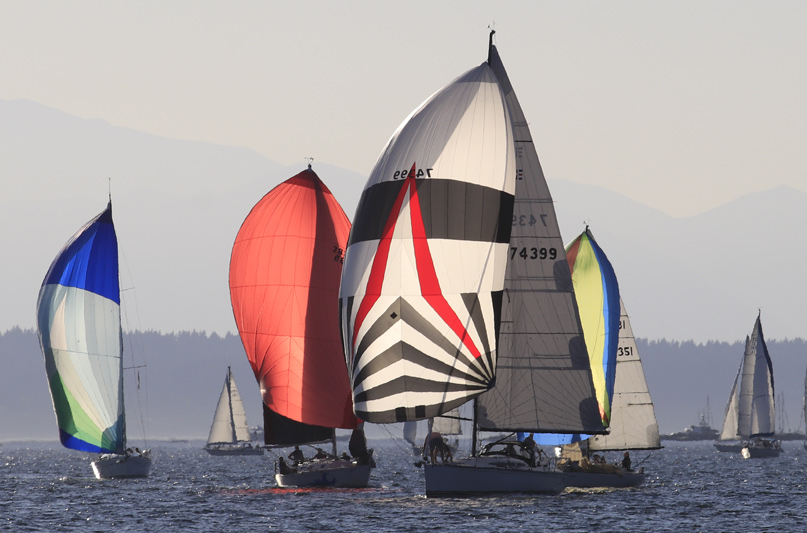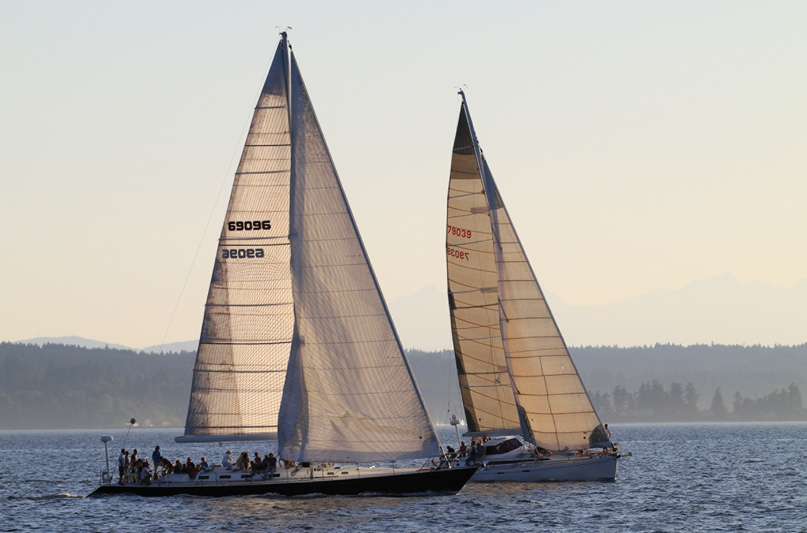
When you venture to the shore of Puget Sound on a summer evening, you’re likely to spy a fleet of white sails dueling around race buoys. Sailboat regattas of all fleet sizes, distances, classes, and levels of expertise are in no short supply, and there’s something going on for the wannabe or seasoned racer every day of the week.
So, you want to get out there, but where do you start? I had the opportunity to chat with Sail Like a Girl crew members Aimee Fulwell, who went from first-time sailor to Race to Alaska (R2AK) legend in a year, and the born-and-raised Pacific Northwest sailor Kate Hearsey McKay. They revealed some tips on how to get your foot in the racing door during our conversation. Fortunately, the Pacific Northwest has a wealth of opportunities to get out there, and you just have to know where to look.
Fulwell and McKay describe Facebook as being a key resource, along with Puget Sound Racing Registry, Puget Sound Crew Board, Women Who Sail and Power Cruise, She Sails, and Seattle Sailing School and Windworks. Sailing Anarchy and other supportive online communities are also at your fingertips. Formal lessons from organizations like the Center for Wooden Boats can be a good step, too.
Other proactive moves include a visit to a sailing association near you and chatting with fellow attendees. You’ll start making bonds with instructors and peers. Yacht clubs often host races as well, like the Corinthian Yacht Club (CYC) that hosts the “low-key” Wednesday Night Sailing Series, which is a great option for first time sailors, according to Fulwell. Sloop Tavern’s Ballard Cup on Monday nights is another solid outlet for those wanting to dip their toes in the scene.
Just like any new sport or activity, a bit of homework is always encouraged, and a sport this old has a language of its own. Fulwell experienced this language shock first-hand. “You hear something like ’Blow the starboard guy!’” she explains, “and you have no idea what they’re talking about. You have to know the vernacular, and that was a thing I had to really hone in on and get to know, whether it was through the Chapman piloting books or websites.”
Not only that, but “there’s a whole lot more terminology that goes along with racing compared to just sailing,” she explains. The Chapman Piloting and Seamanship book is the boater’s bible. You’ll find the basics of almost everything you need to know to go full sail , and familiarizing yourself with the language is a great place to start. Key word is start, so don’t feel like you need to read all 920 pages, line by line, before you can get out on the water.
All this talk of making connections to sailboats and sailing prep is well and good, but McKay believes, “The best thing to do is have your own lifejacket and be prepared for weather.” Gear-wise, Fulwell loves Spinlock personal flotation devices, but everyone has their own taste. She also doesn’t leave home without a quick drying base layer that won’t stink. An offshore jacket is a must, but a set of foulies (foul weather gear) including bibs and a jacket, is even better. Beanies and a neck gator can maintain some heat while on the water, and gloves are hugely important.

The one thing Fulwell didn’t anticipate when getting started was the need for waterproof boots that rise higher than your ankles to keep out the splash. As for McKay, she never leaves the docks without a couple packs of handwarmers and an extra pair of socks. If you have dollar signs for eyes, note that almost all the gear listed above can be picked up secondhand to save a quick buck, either from a post in an online boating community or a trip to a secondhand gear shop like the Wonderland Gear Exchange in Ballard.
When asked for any closing remarks, Fulwell urges the importance of an open mind. McKay encourages those interested in the scene to hang out at the clubhouse post race and be open to learning things and enjoy being a newbie. “You might not be doing anything for a while, and that’s ok, but showing up and being consistent is a really big part of it.”
Overall, Fulwell tells me that simply expressing interest and connecting to people who either have boats or maybe crew on other boats is one of the best things you can do. “Show up to races early, and there’s always a chance that if you bring some beer and walk the docks, there’s a captains’ meeting happening, and they might bring you on board.”
“Just going down there with your lifejacket and lingering a little, asking, ‘Hey, does anyone need crew?’” is a great place to start, explains McKay. “If they don’t have room, they know someone else who does.”
So, there you have it. Read up on your lingo, pick up a six-pack, bring a positive attitude with your gear, own your newbie status, and head to the docks. The great world of racing awaits and there’s a skipper out there that could use the help. Getting into the racing scene is a great way to sail every day without owning a sailboat. No helm? No problem.


